In memory of Dr. Raymond V. Damadian

Submitted: 6 September 2022
Accepted: 8 September 2022
Published: 22 September 2022
Accepted: 8 September 2022
Abstract Views: 939
PDF: 211
HTML: 253
HTML: 253
Publisher's note
All claims expressed in this article are solely those of the authors and do not necessarily represent those of their affiliated organizations, or those of the publisher, the editors and the reviewers. Any product that may be evaluated in this article or claim that may be made by its manufacturer is not guaranteed or endorsed by the publisher.
All claims expressed in this article are solely those of the authors and do not necessarily represent those of their affiliated organizations, or those of the publisher, the editors and the reviewers. Any product that may be evaluated in this article or claim that may be made by its manufacturer is not guaranteed or endorsed by the publisher.
Similar Articles
- Yulin Ge, Seeing is believing: ultra-high field magnetic resonance imaging in vascular and neurodegeneration research , Veins and Lymphatics: Vol. 11 (2022)
You may also start an advanced similarity search for this article.

 https://doi.org/10.4081/vl.2022.10844
https://doi.org/10.4081/vl.2022.10844






